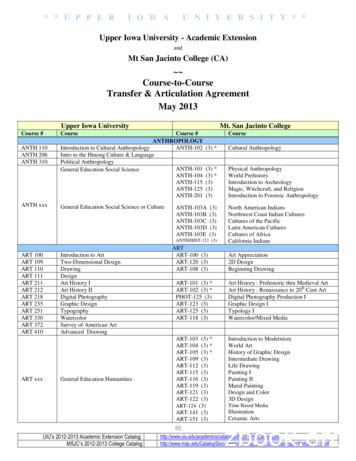Physical Geography: Rocks & Surface Process Methodologies
Physical Geography:Rocks & Surface ProcessMethodologies.1This is the slide footer and goes here03 December 2019
Today’sLearning IntentionsTo examine how student learn about physical processesTo identify methodologies which support student understanding ofrocks cycle and processesTo examine and share methodologies which support studentunderstanding of surface processesTo examine and share methodologies which support student skillsdevelopment for rocks and surface processes2This is the slide footer and goes here03 December 2019
Planning PhysicalGeographyLearning OutcomesPracticalRealSimple3This is the slide footer and goes here03 December 2019
Patterns & Processes in thePhysical EnvironmentLearning objectivesOrdinary Level Students will :Show an understanding of the processes of rock formation,weathering and erosionExplain the processes of landform development involving theinteraction of the tectonic cycle, rock cycle, and surface processesUnderstand and use the skills listed to describe the physicalenvironment4This is the slide footer and goes here03 December 2019
Patterns & Processes in thePhysical EnvironmentLearning objectivesHigher Level Students will :Explain and illustrate the continual process of rock formation,change and destructionExplain and illustrate how landforms develop from the interactionof the tectonic cycle, rock cycle, and surface forcesUnderstand and use the skills listed above to interpret the physicalenvironment.5This is the slide footer and goes here03 December 2019
Leaving Certificate CoreOne Section One SkillsIn the study of this unit,students understand and use, where appropriate, the geographical skills ofmap interpretationfigure interpretationphotograph analysisstatistical analysisfigure drawinginformation technology applications.6This is the slide footer and goes here03 December 2019
RocksLearning Activity – Rock Identification Rock Samples Nails Coins Sandpaper Table mat/worksheet Resources and prior knowledge Markers/Pens703 December 2019Geology Map Jigsaw Geology map of IrelandBlank jigsaw templateColouring materialsLaminating pouchesScissorsEnvelopes for separate jigsaws
Surface Erosion ProcessesFluvial ProcessesHydraulic ActionAbrasion/CorrasionAttritionSolutionGlacial ProcessesPluckingAbrasionCoastal ProcessesHydraulic on8
Fluvial Erosion ProcessesHydraulic Action9Abrasion/CorrasionAttritionSolution
Coastal & Glacial ErosionProcessesCompressed AirPluckingAbrasion.10
Surface Processes andSkillsWith aid of diagram(s) describe the formation of riverlandform.With the aid of diagram(s) describe the formation ofcoastal/glacial landform.11
StoryboardsDescribe theformation of a FluvialLandform12This is the slide footer and goes here03 December 2019Describe theformation of aCoastal LandformDescribe formation ofa Glacial LandformDescribe formation ofa sedimentary rock
Six Minute Activity13This is the slide footer and goes here03 December 2019
Surface Processes – SkillsDevelopment14
Link Skills andUnderstanding,.15This is the slide footer and goes here03 December 2019
Physical Geography: Rocks & Surface Process Methodologies. Today’s Learning Intentions 03 December 2019 2 This is the slide footer and goes here To examine how student learn about physical processes To identify methodologies which support student understanding of rocks cycle and processes
Metamorphic Rocks and the Rock Cycle Section 2: Igneous and Sedimentary Rocks. Section 2 and 3: Rocks and the Rock Cycle There are 3 different types of rocks: Sedimentary Igneous Metamorphic They are all made of minerals One rock can turn into a different type, during the rock cycle. All rocks are formed during different processes.
XY chart: Metamorphic rocks XY chart: Metamorphic and weathering processes. XZ chart: Ignmus rocks. . XZ chart'. Sedimentary rocks XZ chafi Metamorphic rocks and processes, and weathering si chart: Igneous rocks. . . si chart: Sedimentary rocks . . si chart: Metamorphic rocks and processes, and weathering k chart
Sedimentary rocks Sedimentary rocks are those rocks which are formed by the weathered sediments of pre existing rocks (igneous or metamorphic rocks). The geological processes that involved in the formation of sedimentary rocks are as under: 1. Weathering, 2. Erosion, 3. Deposition, 4. Compaction 5. cementation
Sedimentary Rocks and Sedimentary Basins Reading Stanley, S.M., 2015, Sedimentary Environments, - Ch. 5. Earth Systems History On Ecampus Sedimentary Rocks Intro Origin of sedimentary rocks - Clastic Rocks - Carbonate Sedimentary Rocks Interpreting Sedimentary Rocks - Environment of deposition
systematic geography is divided into four main branches. GEOGRAPHY MODULE - 1 The study of Geography as a discipline Notes 5 Nature of Geography as a discipline (i) Physical geography, (ii) Biogeography, including environmental geography, (iii) Human geography, (iv) Geographical methods and techniques
B. Geography . 3 H u m a n / P h y s i c a l TEACHER’S NOTE: Prior to the comple-1. Elements of geography . Geography tion of the two-year global history and a. Human geography . Movement of . geography program, students should . b. Physical geography . People and have a clear understanding of the human c. Political geography . Goods . and .
GEOG 100 Introduction to Physical Geography GEOG-101 (3) Physical Geography GEOG 200 World Regional Geography GEOG-108 (3) World Regional Geography GEOG xxx General Education Social Science GEOG-102 (3) GEOG-107 (3) GEOG-111 (3) Cultural Geography Urban Geography Geography of California HEALTH SERVICES ADMINISTRATION HSA 205 Intro to the .
Ann Sutherland Harris . H. Anne Weis . and . David Wilkins . 1 1.0 INTRODUCTION Caravaggio (Michelangelo Merisi da Caravaggio 1571 - 1610) has been praised and criticized for rejecting traditional painting methods in favor of a dramatic, stark realism that derived its subject matter from daily life. 1 1 Early biographers Giovanni Baglioni and Giovanni Pietro Bellori both write about the artist .























